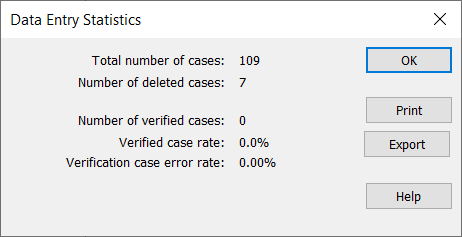Data entry statistics
Snap XMP Desktop calculates statistics about the speed of data entry and whether there were errors.
Viewing the statistics
-
Click Data Entry
 on the Snap Desktop toolbar to display the Data Entry window for the selected survey.
on the Snap Desktop toolbar to display the Data Entry window for the selected survey.
-
Click Statistics
 on the Data Entry toolbar to display the Data Entry Statistics window. The statistics available vary depending on the type of survey and data entry method. If you have scanning enabled, this displays a scanning summary.
on the Data Entry toolbar to display the Data Entry Statistics window. The statistics available vary depending on the type of survey and data entry method. If you have scanning enabled, this displays a scanning summary.

Explanation of statistics
| Statistic | Meaning |
| Total number of cases | Total raw data cases stored for all editions of the current survey. |
| Number of deleted cases | Number of cases deleted for all editions of the current survey. |
| Number of verified cases | Number of cases verified for all editions of the current survey. Note that verified cases become unverified if they have been changed so this value may vary over time. |
| Verified case rate | Number of verified cases divided by the number of cases across all editions, expressed as a percentage |
| Verification case error rate | The percentage of verified cases with errors. |